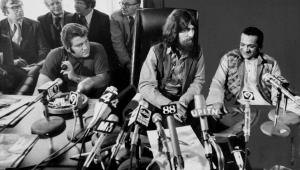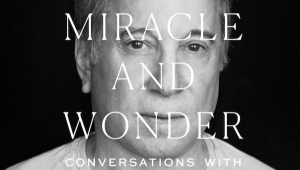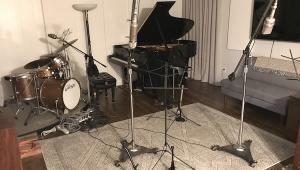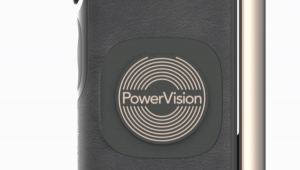Got Live If You Want It! Part 4
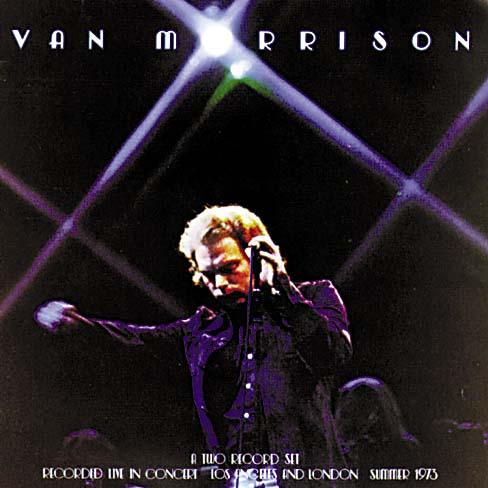
THE GRATEFUL DEAD
Live Dead
Produced by The Grateful Dead, Bob Matthews, and Betty Cantor
Engineered by Bob Matthews, Betty Cantor, Owsley, and Ron Wickersham
Warner Bros. 1830 (2 LPs)
Music:11
Sound:11
So many musical icons have bitten the bullet this decade, so friends have asked me why Jerry Garcia's death bothered me more than the demise of Frank Zappa, John Cage, or Sun Ra. Are they less significant? Not in the least. The analysis is simple: Frank Zappa is best remembered for his recorded legacy - and he had enough warning (unfortunately) of his demise that he properly documented and established distribution arrangements for his collected recordings, including unreleased material.
John Cage permanently changed the course of classical music forever, and his passing cannot alter that. And Sun Ra continues to tour, not letting his death get in the way. But The Dead are remembered for their concerts, not their recordings, and the performances (despite the rave reviews of the recent concerts of the Garcia-less successor band, The Other Ones) are over. None of the studio recordings document the essence of the band's raison d'être and none of the live recordings capture the full experience of a live Dead concert. That is, except for one.
If you must buy only one Grateful Dead recording, let it be Live Dead, a two-record set capturing an astonishing performance from the late 60s. In addition to the best performances I've heard of the Dead classics "St. Stephen" and "The Eleven" (and I've been to too many shows to count), here's a chance to hear a rare live recording featuring the long-deceased vocalist Pigpen (Rod McKernan), "Turn On Your Love Light."
But the single reason to buy this recording is the side-long rendition of "Dark Star," the Dead song that best typifies the band's ability to apply free-jazz improvisational techniques to non-blues-based rock ballads. This one cut, with its passionate ebbing and swelling instrumental interlude, has had profound influence on many of today's bands and musicians, from Sonic Youth to the young New Jazz lions. It brings me back to my high-school graduation party. I set up a "makeout room" with two beds in the attic's spare bedroom, I hooked up my General Electric portable ceramic-cartridge stereo to a five-channel color organ sporting high-Wattage dichromatic floodlights (built it myself - even etched my own circuit boards!), pointed it at the ceiling, and set the record changer on “repeat” with “Dark Star” on the platter. Couples alternated beds until 6 a.m. while depleting my parents' liquor cabinet (by 5:30 all that remained was bourbon and Cream soda - hey, it worked).
I haven't heard a better "Dark Star," and I've heard no other Dead recording that mentally, physically, and emotionally transported me to a live show as this has. Sound quality is the best I've heard from any live rock recording, and it's the best recording (and performance) of Garcia's guitar on record - assuming you like the sound of an occasionally primitively processed Gibson SG standard guitar continuously panned around the soundstage. Except for the fact that Garcia's voice was panned hard left, the staging on the record is exceptional. Haven't heard the CD.
- Bob Reina
VAN MORRISON
It's Too late To Stop Now
Produced by Van Morrison and Ted Templeman
Engineered and mixed by Donn Landee
No mastering credit (LP)
Mastered by Ian Cooper and Walter Samuel at Metropolis Mastering (CD)
Warner Bros. 2BS2760 (2 LPs)/London Polydor Records 31453 7453-2 (2 CDs)
Music: 10
Sound: 9
This is one for the ages, folks. Recorded at The Troubadour in Los Angeles, as well as at The Santa Monica Civic Center and Rainbow Theater, London, during Van Morrison's 1973 tour, It's Too Late... captures the intimate magic Van was (and still is) capable of creating in concert, here backed by. the Caledonia Soul Orchestra.
The lineup consisted of Jef Labes, piano and organ (as well as string arrangements); Dahaud Shaar, drums; John Platania, guitar; David Hayes, bass; Jack Schroer, saxes and horn arrangements; Bill Atwood, trumpet; Nathan Rubin, Tim Kovatch, and Tom Halpin, violins; Nancy Ellis, viola; and Terry Adams, cello.
Originally slated as a three-album set (Warner Bros. even went ahead and cut acetates for a triple-vinyl set), the label got cold feet and decided to cut the track list down to two records. Some of the songs lost in the purge included "The Way Young Lovers Do," "Purple Heather," and "Sweet Thing." Too bad; but let's focus our attention on what was kept, not what we have lost.
The album opens with a tight but supple jazz/blues number, "Ain't Nothin' You Can Do About It," which gives the horn section ample opportunity to flex its muscles. The true standout on this number, however, is Jef Labes, whose tasty piano fills give this average song a darker texture. This tour was launched in '73 to support Van's then-new album, Hard Nose The Highway, one of his most underrated albums - and one that's cohesively stronger, in my opinion, than the critic's darling Astral Weeks.
Morrison's first offering from the new album is "Warm Love." The studio version is a straightahead love song, but here the band really propels it into something much stronger, with, of course, much assistance from Van. It is fascinating to hear the horn section, bass, and drums trying to match Van's vocal ad-libbing note for note, giving this live version more panache than its studio counterpart.
"Into The Music" follows, with the lush strings carrying it along. Near the conclusion, Van shouts out to the audience, "I just wanna rock your soul!" - as clear a summation of Van's musical mission as you're likely to hear.
The highlight of Disc 1 is Ray Charles' "I Believe To My Soul," a slow blues which Van makes his own. With background piano and strings giving the song a smoky, late-night bar feel, the performance could make the soundtrack to any detective movie.
After a few more R&B numbers, Van hits us with "Wild Children," a touching song about life in the mid 1950s, also from the Hard Nose album. Van's ability to pull off such a quiet, reflective song in concert attests to both his charisma and the attention span of audiences back then. Could he get through this tune today without some jackass screaming, "Play 'Moondance!'”? After mellowing the audience, Van closes Disc 1 with a rollicking "Domino."
Disc 2 kicks off with another cover, Sam Cooke's "Bring It On Home To Me," which Van gives a slow, respectful, almost reverential reading. Next he switches gears with the title track to 1972's Saint Dominic's Preview - a tune that demonstrates why Van prefers working with jazz musicians. It's a loose, free rendition that allows the musicians to stretch beyond the straightforward chord and key changes found on the “straightahead” studio versions.
Van winds Disc 2 down with some crowd favorites from his Them days, including "Here Comes the Night," greatly enhanced by the string section, which transforms the song from a simple R&B number into something more (dare I say it?) classical. The seminal "Gloria" follows, as Van proceeds to officially rock the house and bring the audience into the act with chants of "G-L-O-R-I-A - GLOR-OR-RIA!"
The master showman takes them higher and higher, finally bringing the song to a crashing conclusion. With the crowd now firmly in the palm of his hand, Van and band launch into the greatest live "Caravan" I've ever heard (bettering even the version from The Last Waltz!). The song closes and the crowd goes home shaking its heads in collective bliss. Oh, to have been there that night!
The sound quality on this album is exquisite. Highs are crystal clear with no disturbing sharpness. On this remastered CD I can follow the bass line all the way through, unlike the vinyl. Snares and high toms sound pronounced, yet not grating. This a perfect live album.
- Andy Goldenberg
MOTORHEAD
No Sleep 'til Hammersmith
Produced by Vic Maile
No engineering credit
No mastering credit
Dojo Records/Castle Communications Dojo 3035-2 (CD)
Music:10
Sound:10
Having been given the boot by the progressive/electronic group Hawkwind in 1975, bassist Lemmy Kilminster formed Motorhead (British slang for a speed-freak). The band gradually gained a rabid cult following by playing the various industrial towns of England. By the early '80s, after years of grueling touring and several British chart successes, the band recorded arguably its greatest studio album (with the possible exception of 1916), Ace of Spades.
Acclaimed by critics, Ace of Spades encapsulated the best qualities of the band: power, speed, volume, and versatile musical chops. Backed by record company promotion, the band, consisting of Lemmy on vocals and bass, "Fast Eddie" Clarke on lead guitar and vocals, and drummer Phil Taylor, stormed its way through the Ace Up Your Sleeve tour like Vikings on a rampage. They arrived back home to London in late November, 1980 for a series of shows at the prestigious Hammersmith Odeon, from which this album was culled.
The concert kicks off with some classical music as the band revs up and launches into "Ace of Spades," which metaphorically compares a card game to survival of the fittest in the game of life (I could see Darwin head-banging to this!). Fast Eddie Clarke churns out power chords in time with Lemmy's pulsating bass as Phil Taylor leads the charge on drums. The sound is blissfully deafening. One could officially declare this song "speed metal." As this song concludes, the audience barely has enough time to catch its breath before the band cranks it up Ramones style for "Stay Clean," a tale of keeping your life together on the road. Lemmy's bass playing is spectacular, easily rivaling that of Yes' Chris Squire in both technique and intensity.
The band changes gears with the next tune, "Metropolis," beginning with familiar metallic chord changes and then suddenly segueing discreetly into some progressive-rock tempo changes complimented nicely by a vintage '70s wah-wah guitar solo. Imagine Motley Crüe attempting this? Get real! After a prototypical metal number, "The Hammer," The 'Head launch into my favorite song on the album, "Iron Horse," an obvious tribute to an expired biker (bikers were early Motorhead supporters, you know).
The song begins with a funky drum-and-bass pattern - further testimony to the band's versatility - as Lemmy laments, "He rides the road, lives life fast/ don't try to hide, when the die's been cast/ on an iron horse he flies/ on an iron horse, he lives and dies." Poetic, simple, yet when combined with the right amount of distorted guitar, perfect. The next song, "No Class," begins with a '50s shuffle thrown into a metal stew. Drummer Taylor really kicks maximum British ass as Clarke makes an honorable attempt to keep up with his frenetic skin pounding. This is what live music is all about, my friends! After a tribute to their road crew, originally titled, "We Are the Road Crew," the boys wind it down with "Capricorn," "Bomber," and the classic Hawkwind track, "Motorhead." Fans are satiated, ear drums are bleeding; what a great night!
Though Motorhead has undergone as many lineup changes as Spinal Tap, this album proves what a ferocious live act it was and still is. What separates Motorhead from the rest of the pack, and what has obviously sustained the band for over 20 years of recording, is its versatility. The band plays heavy metal, speed metal, progressive metal, and rock 'n' roll with equal passion and aplomb. No Sleep 'til Hammersmith captures that fiery intensity at its zenith.
The reason I picked this album as my other all-time live favorite is that it has the truest "live" sound of any album I've ever heard (and that's on both the vinyl and CD). Though the Van Morrison sounds excellent, it still has a polished sound to it. Not so here, as this is a "warts and all" recording. The guitars and microphones feed back every now again and listeners feel like they're standing front row and center at the Hammersmith. The sonic force is so great that you not only hear the power of Motorhead, you feel it like a kick to the solar plexus! When I crave an authentic concert experience without leaving my living room, I slip in this disc, crank it up to "11," and revel in the sonic typhoon that is Motorhead.
- Andy Goldenberg
JAMES BOOKER
Live at Montreux
Produced by Phillipe Rault
Engineered by David Richards
Edited by Warren Dewey
Mastered by Chris Bellman at Bernie Grundman Mastering, Los Angeles
Montreux Sounds 1967-30001 (CD)
Music 10
Sound 9
The highly revered, highly eccentric New Orleans piano maestro, who died in 1983, made too few recordings in his lifetime. If you're already a fan, you'll count this live snapshot, released only last year, among the best of Booker; if you're new to Booker, this 1978 recording is one of his most fun, opening as it does with a medley of "Penny Lane," "I Saw Her Standing There," and Booker's signature tune, "One Helluva Nerve."
Longtime enthusiasts will be pleased to find a version of a tune by the New Orleans clarinetist Louis Cottrell, "True," as well as a couple of fine Booker originals, "The Long Last Laugh" and "Look What I've Got." Also included are rollicking versions of the Booker standards "Junco Partner," "Tipitina," and his own "Papa Was a Rascal."
The first half is just Booker and piano; for the second half, a backing trio kicks in with some hot licks contributed by guitarist Cash McCall. At the top of his game, it was almost impossible to beat Booker. No one in American music blended virtuosity and funk as effortlessly. Although much of his short life was lived tragically, on Live at Montreux Booker revels in his sublime talent, performing with supreme joy, as if he hadn't a care in the world.
- Roger Hahn
JANIS JOPLIN WITH BIG BROTHER AND THE HOLDING COMPANY
Live at Winterland '68
Produced for compact disc by Bob Irwin
Mixed and mastered by Vic Anesini at Sony Music Studios, New York
Columbia Legacy CK 64869 (CD)
Music: 9
Sound: 8
Janis clearly was the psychedelic inheritor of the legacy of Bessie Smith. Janis truly was a blueswoman through and through, and her early work is a towering monument to terrifying honesty and personal embellishment. But you'd never know it from her recorded works, all produced at the hands of those who would rather exploit a fragile young woman than celebrate her true accomplishments.
Live at Winterland '68 is the real Janis. Taped just prior to the imposition of a major-label contract and being released now for the first time - ironically, to celebrate the 30th anniversary of that signing - it includes two full sets that showcase what would become her classics: "Down on Me," "I Need a Man to Love," "Ball and Chain," "Piece of My Heart," and the extraordinary "Summertime" - performed with all the high-wire passion and raw-nerve theatrics that were to become her trademark, and supported most passionately by Big Brother and the Holding Company, the prototypical Bay Area band, which both her manager, Albert Grossman, and her label convinced her to dump only six months later.
As the liner notes reveal, even Cheap Thrills (previously her only available "live" recording) was a slick lie, produced in the studio and faked to sound live. My advice? Accept no substitutes. Now that we have this honest portrait of the artist, we can ignore the rest of her catalogue and let Janis be remembered as she would want to be, for this one recording alone.
- Roger Hahn
ART BLAKEY QUINTET
A Night at Birdland, Vol. 1
A Night at Birdland, Vol. 2
Produced by Alfred Lion
Produced for this release by Michael Cuscuna
Engineered by Rudy Van Gelder
Digital transfer by Ron McMaster
Blue Note CDP7-46519-2 and 46520-2 (CD)
Music: 9
Sound: 9
Practically before the advent of the long-playing vinyl record (imagine!), definitely before stereo (yikes!), and just before any of the four major participants (Art Blakey, Clifford Brown, Lou Donaldson, and Horace Silver) had established their standings in the world of jazz, Blue Note's renowned engineer, Rudy Van Gelder, dragged some recording gear down to this basement club on Broadway, just around the corner from 52nd Street, on the eve of Washington's Birthday, February 21, 1954, to produce what is essentially the first field recording ever made in bop's natural habitat - and one of the finest live recordings in the history of jazz.
How new a phenomenon was the nightclub recording? So new you can hear the exquisitely hip master of ceremonies, Pee Wee Marquette, tell the audience, by way of an introduction, "When you applaud for the different passages, your hands go right over the records, so when they play 'em over and over throughout the country, you may be some place and say, well, that's my hands on one of those records, that I dug down at Birdland!"
What follows is almost two hours of hard blowing from youthful masters of the craft, featuring "the new trumpet sensation, Clifford Brown" and with the ensemble as a whole sailing along just blissfully amidst surroundings so apparently intimate you can practically smell the sweet aroma of stale cigarette smoke. Monodynamic, but incredibly full-bodied, sound that's just a touch - a delightful touch - rough around the edges. The occasional exclamation of approval from members of the high-spirited audience. A trio of Horace Silver compositions. A couple of blues. A standard or two. A 10-minute version of "A Night in Tunisia." A pair of Charlie Parker tunes to end the night. Blakey blazing behind the traps all the way.
Not only a classic recording, the genesis of the Jazz Messengers, and the only live recording of Clifford Brown, but a big, fat slice of real nightlife from a time when this kind of jazz played in this kind of nightclub was about as close as you could get to music-lovers' Heaven.
- Roger Hahn
OZRIC TENTACLES
Live Underslunky
Produced and engineered by Ed, C-Live, and Haggis
Recorded by C-Live and Glen
No mastering credit
RGB Records RGB 505-2 (CD)
Music 10
Sound 9
“Progressive rock” never died, it just evolved. One of the best groups to tackle prog's musical Darwinism is Ozric Tentacles, beginning with the quirky cover art by the singular Blim, who borrows heavily from the cover of Gong's 1973 release Radio Gnome Invisible Part 1 (“The Flying Teapot”). The track titles give further evidence of the group's prog-rock psychedelic eccentricity, with names like “Dots Thots E,” “White Rhino Tea,” “Kick Muck,” and “Ayurvedic,” which adds a bit of a holistic bent.
Finally, the music itself carries on the tradition of the finest aspects of space fusion rock with a simple combination of synth, guitar, flute, drums, and bass ecstatically bouncing from frantic fusion to “out there” atmospherics. The band also dabbles in “prog” reggae and dub. Ozric music is improvisational keyboard versus guitar, with a strong drum-bass rhythm foundation that rarely founders in self-indulgent noodling. The guitar work brings to mind Steve Hillage's stint with Gong, with, as another reviewer put it, “none of the metaphysical bullshit.”
In addition to the obvious influence of the Planet Gong trilogy, Ozric is also decidedly inspired by Hawkwind (directly credited a quarter of a century ago on Radio Gnome), Amon Duul, Djam Karet, Pink Floyd, and Jethro Tull. The band has a loyal festival-going contingent in the U.K. and a cult following is alive and well in the U.S. Ozric Tentacle was touted as one of the best bands of 1990 with its Erpland album.
Live Underslunky, the follow-up to being cooped up in the studio, stretches-out righteously. Recorded at gigs played in Manchester and Cambridge in November of 1991, fresh versions of many of the group “favourites” abound, including the requisite “Erpland” and “Bizarre Bazaar.”
Live, Ozric is especially fueled by the astounding volleys between Ed Wynne's guitar and Joie Hinton's ethereal electronics. Wynne's chops are tight and Hinton coaxes sounds out of his machines that are otherworldly. The positioning is up-front across the board and very hot, but that seems to be a necessary expansion, considering the intensity of the tunes. Clearly and precisely mixed, you can almost believe it is studio work, until the sounds of the audience trickle through at the end of a song.
The electronics are particularly enjoyable, as they dance about the field and demonstrate Hinton's sound-crafting abilities. The flute lends a thrilling Middle-Eastern effect, and the drum-and-bass solidarity never gets sloppy, even with jazzy breaks and dub slowdowns.
On a trivia note, an “underslunky” is a scratchy and generally unpleasant woolen waistcoat worn beneath a shirt, described by the band as “really horrible and uncomfortable.” Perhaps the bandmembers are creating an analogy to the rigors of touring, but it doesn't show! For the purists, Mother Gong tours regularly, but I recommend also catching Ozric - I experienced the band getting that trademarked studio-recording energy out to the audience. And Live Underslunky lights and carries the live progressive rock torch as effectively.
The prolific Tentacles reach out to many a spin-off project: Eat Static: space techno, heavy on the alien abduction theme; Wooden Baby: no description! Guess we have to figure it our for ourselves.... The Oroonies: described as a “pagan psychedelic punk folk band”; Nodens Ictus: the “ambient” Ozric Tentacles without bass, drums, and guitar; The Ullulators: “everything from rootsy dub to Pat Benatar!” (one track on the magnificent Feed Your Head compilation from Planet Dog). (For more on Ozric, et al., go to the newsgroup alt.music.progressive.)
- Stacy Meyn
ORB
live 93 AKA bro evil 39
Produced and engineered by The Orb and Andy Hughes
Recorded by BBC Transcription
No mastering credit
Island Records CIDD 8022 (2 CDs)
Music 10
Sound 10
The Orb has been hailed as everything from the “Pink Floyd of the '90s” to "the new Brian Eno” ever since it rolled out its unique brand of “ambient-house” around eight years ago as post-rave tunage to mellow out, yet motivate, the attendees. Harvesting and collaging pre-existing music and sound, “Dr.” Alex Paterson - the “center” of The Orb - escaped his job at Eno's label and created the 1991 sonic masterpiece Adventures Beyond the Ultraworld.
An example of Paterson's technique involved using a “found sound” like a page turning in a book and transforming it into the aural equivalent of a hi-hat cymbal. “The Blue Room” (produced by Steve Hillage) set the record for longest single (over 45 minutes of audio excursion), and the 1992 release UFOrb spawned a bootleg remix adaptation of Pink Floyd's Wish You Were Here. Also with The Orb core are the aforementioned Gong-man Steve Hillage, Youth (Martin Glover) of Killing Joke (for whom Paterson originally worked as a drum roadie), and Jimmy Cauty (best known as part of The KLF).
Live Orb is Paterson (AKA "dr lx paterson" while DJing) on keyboards and sound manipulation, Thrash (Kris Weston) mixing, and Nick Burton, Simon Phillips, and a personage called Fluff on various audio duties. Recognized DJs Craig Walsh, Paul Oakenfold, Justin Robertson, Bandulu, and Tony Thorpe (The KLF) lend their skills. The Orb's live 93 has all the “hits,” such as “A Huge Ever Pulsating Brain That Rules From The Centre Of The Ultraworld” (with the famous “Lovin' You” bit sampled from Minnie Riperton) and the direct assault of “Little Fluffy Clouds” (yes, the mystery guest voice is Rikki Lee Jones), which most recently has been heard in the new VW Bug ads. The Pink Floyd-ian album art for this double-disc set is by Madark - in this case, a toy sheep floating over a processing plant. The “live orbient” sound is enhanced by cleared and credited samples of Dr. Martin Luther King, Lee Scratch Perry, Grace Jones, Ry Cooder, Mad Professor, and more. Tracks are taken from the famous Glastonbury Festival, as well as performances in Copenhagen and Tokyo.
This could be accused of being a studio effort, and properly so: after all, how “live” can samples be? How and why live 93 succeeds is due to the spontaneous and new combination of sounds each time the project “presents” a song. Consummate knob-twiddlers and fader jockeys take chirping birds, the Doppler effect of a motorcycle whizzing by, the cacophony of a British telephone ringing - even a purring kitten - and weave them into the track bed, blending them so they are not really realized as samples. Clever voice snippets are used, some historical, some hysterical. The rhythm is primarily dub, tirelessly loping along, mimicking our heartbeats and inspiring more than a touch of rumination on the part of the listener. The production is studio-level and does not annoy with any “live” drags like unwanted noise (though that is difficult to imagine with this recording) or lack of consistency in levels. It is solid and even throughout, and offers something new with each listen.
Currently there is a new streamlined Orb consisting of Paterson, Andy Hughes, and “floating” member Thomas Fehlmann, who has, over the years, played a role in a number of Orb outings, including live 93. They continue to boggle the eyes and ears with their aural experimentation, in and out of the studio setting.
- Stacy Meyn






